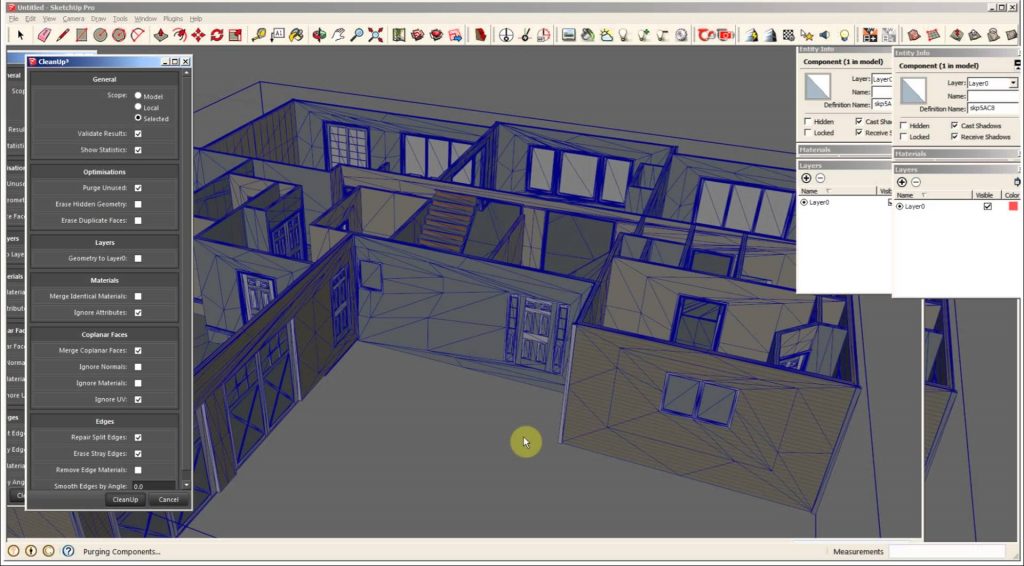Learn Plugin Developement
In this SketchUp article briefly describe top five film & stage plugin you can work with to create a film or stage set, such as Sky Dome, Thumb Cinema, and much more. The extension allows you to replace SketchUp's sky gradient with a real sky image that includes the sun, clouds, and stars. This is part two of my last video with 5 more free plugins 🙂 I've been using these extensions for years and I wouldn't be recommending them if I didn't think they'll actually help you! If you don't know how to install Sketchup Extensions/Plugins, follow this link. Sketchy FFD by CPhillips. Sketchy FFD adds a 'control cage' to an object, allowing you to create complex curved, forms from gridded surfaces. It raises the possibility of creating domes, arches or free-flowing organic shapes constructed from 'weaved' elements or mesh. A full demo is available here, and the plugin can be downloaded here.
There are many tutorials, resources and forums available online that will help you get started. Use the following list as a springboard:

- Hello world!
- Distributing your plugin
- SketchUp API documentation
- SketchUp Ruby Cheatsheet
- Official SketchUp API Blog
- SketchUp Ruby Resources
- Ruby Code Snippets
- Ruby Documentation
You can also find great forums for discussion in the official Developer Forum or at SketchUcation.
The following concerns plugins written in Ruby (the programming language included with SketchUp's free and Pro versions). It is a basic template to get you started. Also note that SketchUp has a C++ SDK (in case you intend to work with it from other software).
Although you can use any text editor to create a plugin, it might be a good idea to install my Ruby Code Editor plugin into SketchUp first. This allows you to experiment with Ruby scripting. You can then afterwards package your code in a plugin using the instructions below.
RBZ Plugin File Structure
The RBZ file format was introduced in Maintenance Release 2 of Version 8. Packaging a plugin this way allows a user to easily install it from SketchUp's Preferences dialog.

- Hello world!
- Distributing your plugin
- SketchUp API documentation
- SketchUp Ruby Cheatsheet
- Official SketchUp API Blog
- SketchUp Ruby Resources
- Ruby Code Snippets
- Ruby Documentation
You can also find great forums for discussion in the official Developer Forum or at SketchUcation.
The following concerns plugins written in Ruby (the programming language included with SketchUp's free and Pro versions). It is a basic template to get you started. Also note that SketchUp has a C++ SDK (in case you intend to work with it from other software).
Although you can use any text editor to create a plugin, it might be a good idea to install my Ruby Code Editor plugin into SketchUp first. This allows you to experiment with Ruby scripting. You can then afterwards package your code in a plugin using the instructions below.
RBZ Plugin File Structure
The RBZ file format was introduced in Maintenance Release 2 of Version 8. Packaging a plugin this way allows a user to easily install it from SketchUp's Preferences dialog.
To enable use of the RBZ-installer functionality, all files that make up a plugin must be packaged in one single compressed file (note that the RBZ file is simply a re-named ZIP file).
Best softwares for mac. As a reference: SketchUp's default Plugin installation folder can be found here (replace version number with current major version):
Windows: C:Program FilesGoogleGoogle SketchUp 8Plugins
Mac: /Library/Application Support/Google SketchUp 8/SketchUp/Plugins/
Plugin Template
It is a good idea to a) use SketchUp's extension system and b) wrap your plugin in a Ruby Module. Below is some sample code to get you started. Replace 'my' with your initials to keep things clean.
Contents of /my_plugin_loader.rb (in main directory)
Contents of /my_plugin/my_plugin.rb (in subfolder)
Plugin Sketchup 2018
Please note: If you prefer to not have your plugin's source code visible, then you can use SketchUp's Scrambler to encrypt Ruby files.

